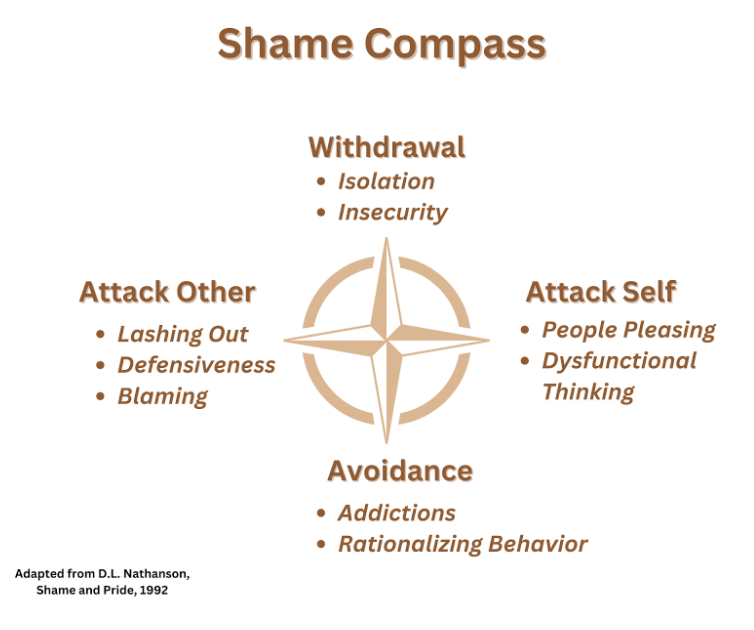
You might not say the words “I feel ashamed”—but you might recognize the fallout: pulling away from people, snapping over small things, or constantly trying to prove your worth. This is the hidden work of shame.
Shame doesn’t just live in your thoughts—it seeps into your reactions, your relationships, and how you see yourself. This is why shame makes you shut down…it’s everywhere. When shame enters the picture, it’s not always loud or obvious. Sometimes, it shows up as silence, as withdrawal, or as pretending everything is fine. But deep down, the feeling of unworthiness begins to drive everything.
One of the most powerful tools for healing is awareness. And one of the clearest maps to that awareness is the Shame Compass—a framework that shows how we respond when shame takes over. Learning how you shut down, and why, is a brave step toward healing.
When you feel ashamed, your brain doesn’t pause to reflect. It reacts. This is why shame makes you shut down…it’s affecting the same parts of the brain as physical pain. Your nervous system treats it as a threat—and you do what you’ve learned to do in the face of threat: shut down, lash out, avoid, or turn on yourself.

The Shame Compass outlines four default responses to that inner feeling of unworthiness:
These aren’t moral failures. They’re survival strategies. They once helped you cope, stay safe, or protect yourself from deeper harm. But now? They might be keeping you stuck.
Understanding your direction on the Shame Compass isn’t about judgment—it’s about naming what’s been happening under the surface so you can start choosing something different.
This is the most common response when shame makes you feel exposed. You might:
You might even convince yourself that you’re “just tired” or “need alone time,” but deep down, it’s fear. Fear of being judged. Fear of being seen and rejected.
If you disappear first, no one can push you away. It’s a protective instinct. And while it may feel safer in the moment, over time, it reinforces the lie that you’re too much—or not enough—to be loved as you are.
Shame teaches you that silence is safer than vulnerability. But healing teaches you that connection is what brings shame into the light.
This can feel like:
It’s often confused with anger—but it’s not about power. It’s about protection. If you can go on offense, maybe no one will see how scared or small you feel inside.
Shame can make you feel worthless. Attacking others gives a temporary sense of control. It creates distance that feels safer than vulnerability.
It’s easier to point the finger than to admit you feel broken. But every reaction rooted in shame is really a cry for safety.
You stay busy. Distracted. Overwhelmed. You might:
You may tell yourself you’re just decompressing—but the truth is, you’re avoiding the feelings you’re afraid to sit with.
Stillness can feel dangerous when your inner voice is full of shame. Keeping busy keeps those feelings at bay, but it also delays healing.
You can’t heal what you won’t acknowledge. Numbing the pain might quiet it—but only for a little while.
This is the most inward-facing response. You might:
This response tells you that you are the problem. Not what happened. Not what someone did. Just you.
Shame has convinced you that you deserved the pain. That you’re fundamentally flawed. Attacking yourself becomes a way to punish what you’ve internalized as broken.
You are not the bad thing that happened. Shame twists your story, but healing untangles the truth.
Recognizing your go-to shame response doesn’t mean you’ve failed. It means you’ve survived.
These reactions formed to protect you when you were hurt, silenced, ignored, or manipulated. But what helped you survive then may be keeping you stuck now and it’s why shame makes you shut down. And the moment you recognize your response, you create space to respond differently.
You might still feel the pull to hide, lash out, or numb. But with awareness, you can choose presence instead of protection. You can choose healing instead of hurt.
Naming your reaction is the first disruption. It’s the moment you stop running and start rewriting.
When shame hits, shutting down can feel like the only option. It’s how many of us learned to stay safe—by pulling back, going quiet, or disappearing emotionally. But healing begins when we gently interrupt that pattern.
The first step? Awareness.
See the patterns.
Name the behaviors.
Offer compassion to the part of you that learned to survive this way.
You don’t have to fix everything all at once. You don’t have to force yourself to feel better. But if you can name what’s happening—“I’m shutting down because I feel unworthy right now”—you create space for something new.
Awareness is powerful because it puts you back in control.
Instead of slipping into silence or self-blame, you can pause. You can take a breath. You can remind yourself: This reaction makes sense. I’ve used it to protect myself. But I’m allowed to choose something different now.
Awareness is what turns a reflex into a decision. It’s what lets you say, “I see what’s happening—and I don’t have to keep going down this path.” That moment of recognition is a crack in the armor shame built—and through it, healing can begin to shine.
Shame doesn’t mean you’re weak. It means you’ve been hurt. And the ways you’ve coped? They make sense.
Now, you’re allowed to choose something different. You don’t have to attack, hide, numb, or shrink anymore. You’re worthy of healing—and you’re not alone in this work.
You don’t have to do this work alone. Let’s talk if you’re ready to stop living by shame’s compass and start healing on your own terms.
Still thinking it through?
Join the mailing list for ongoing support, healing stories, and tools to reconnect with your worth.
p

loree@loreetamayo.com
210.326.6662
1320 Arrow Point Drive, Ste. 501
Cedar Park, TX 78613
Design by Bradcable